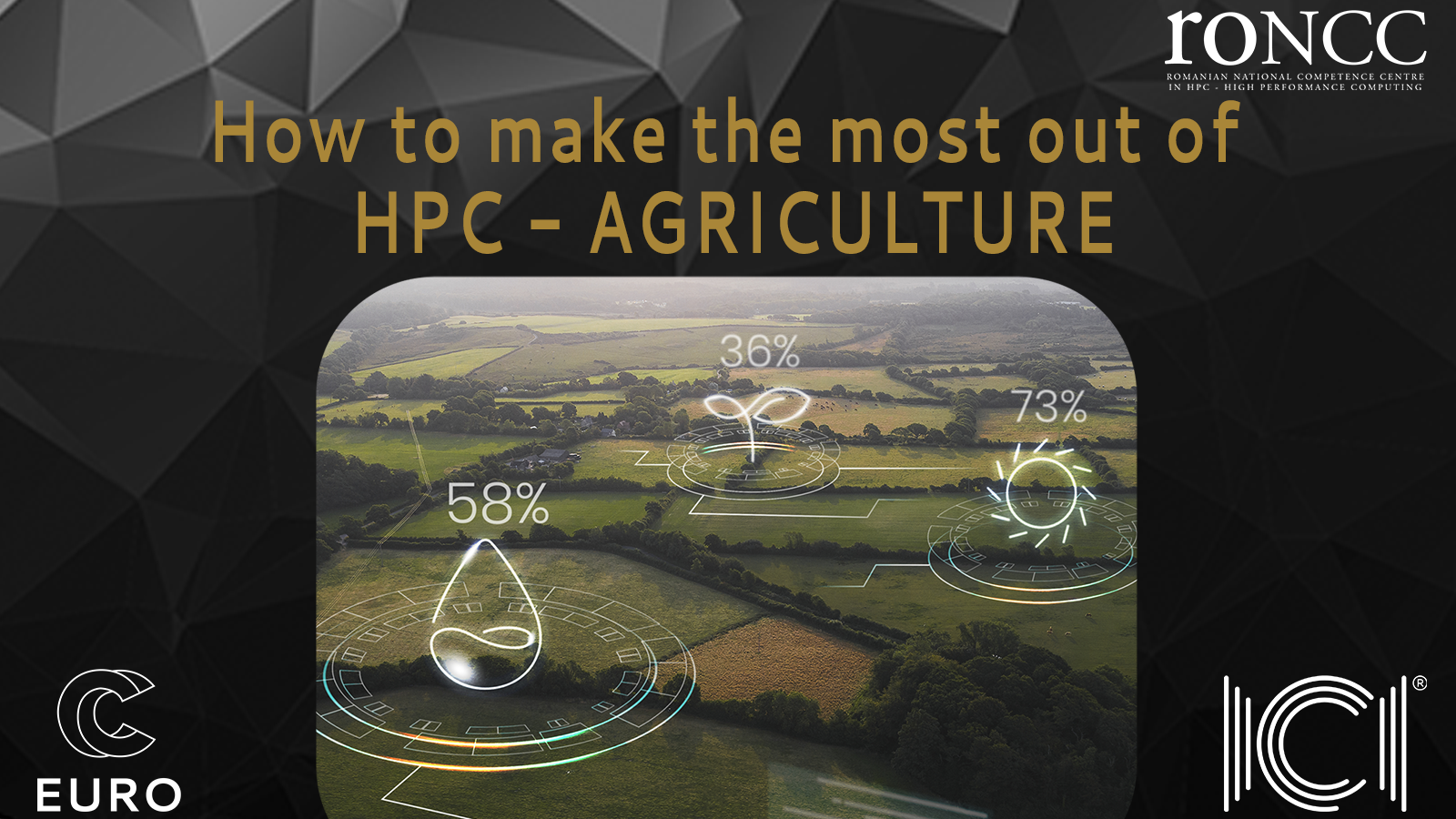Call for Applications: BioExcel Workshop Balkan Edition
BioExcel organizes the BioExcel Workshop Balkan Edition, a two-day hybrid event designed to inspire and empower early-stage researchers passionate about biomolecular modeling and simulation.

High-Performance Computing can be used to create simulations, reducing the need for physical testing, it can perform large-scale computations in minutes instead of weeks or months, saving time and money.
The main benefits in the agriculture sector are with regards to Precision Agriculture, Precision Livestock Farming, Crop Yield Forecasting, Manufacture of Mechanization Tools, Geoprocessing Services.
To better understand how HPC solutions can be used in this domain, we have put together 5 use cases, each with a different application:
Dictated by the weather, farming tasks have often to be carried out within a short time window. Consequently, equipment has increased in size to complete the work rapidly. One alternative solution is for farmers to manage fleets of smaller, autonomous vehicles and carry out the tasks as required. The range of operations to be delivered include soil chemical analysis, hyperspectral imaging (HSI) of soil/crop condition, real time object level (plant/weed) identification, individual plant harvest readiness assessment (particularly for soft fruits) and plant level automated harvesting, currently not possible because it would be massively labor intensive. The ultimate goal is for minimally sized equipment, e.g. a small tractor or scouting vehicle to carry the sensory devices e.g. spectral analysis equipment, imaging (visible and HSI). Such sensor ‘transporters’ can be combined with a network of ‘actuator’ devices such as plant level harvesters, precision soil enrichment vehicles or cultivation/planting equipment. It is envisaged that a pair (at least) of systems can operate in tandem on a given task with the sensory elements passing over the crop relaying measurement data to a central location. The data can then be processed to identify plant, weed, readiness for harvest etc., generating the inputs for the actuator to harvest the appropriate plant.
Read more about it here: https://www.sciencedirect.com/science/article/pii/S1389128619305353
2. Precision Livestock Farming - Aquaculture
Within the Cybele project, aquaculture monitoring and feeding optimization is one of the nine use cases defined to address the above issues. It aims to ensure that fish food, which accounts for up to 70% of costs on fish farms, is given to stocks at the optimum time and appropriate levels to promote growth and reduce pollution from rotting food debris. The intention is to make use of drones, image processing and data mining to optimize feeding, evaluate the impact on the environment and evaluate the status of the infrastructure in open sea aquaculture.
Read everything about it here: https://www.cybele-project.eu/post/where-agriculture-and-livestock-farming-meet-high-performance-computing
3. Crop Yield Forecasting
NCSA Professor Kaiyu Guan and Bin Peng have implemented and evaluated a new maize growth model. The CLM-APSIM model combines superior features in both Community Land Model (CLM) and Agricultural Production Systems sIMulator (APSIM), creating one of the most reliable tools for long-term crop prediction in the U.S. corn belt. Peng and Guan recently published their paper, “Improving maize growth processes in the community land model: Implementation and evaluation” in the Agricultural and Forestry Meteorology journal. This work is an outstanding example of the convergence of simulation and data science that is a driving factor in the National Strategic Computing Initiative announced by the White House in 2015.
With support from the NCSA Blue Waters project, NASA and the USDA National Institute of Food and Agriculture (NIFA) Foundational Program, Peng and Guan created the prototype for CLM-APSIM. “We built this new tool to bridge these two types of crop models combining their strengths and eliminating the weaknesses.”
Read more about it here: https://insidehpc.com/2018/02/supercomputing-better-tools-long-term-crop-prediction
4. Manufacture of Mechanization Tools
When the cotton harvest season started in October, the vast cotton fields in northwest China's Xinjiang Uygur Autonomous Region saw roaring cotton-picking machinery instead of cotton farmers. Thanks to the machinery, Dilshat Memet, a cotton farmer in Yuli County, Bayingolin Mongolian Autonomous Prefecture, completed cotton picking in just one day. But in the past, he would be busy collecting cotton all through the harvest season.
"The high-efficiency cotton picker can handle the workload of several hundred people. For generations, my family used to harvest cotton by hand and traditional implements", Dilshat Memet said.
"At least two workers are needed to manually pollinate for each mu (0.07 hectares) of pear trees. But a drone can pollinate 2.6 hectares of pear trees within an hour, and the yield of pears can increase at least 500 kg per mu", said Peng Wenjun, an expert of the Chinese Academy of Agricultural Sciences.
Read more about it here: https://www.brics-ict-hpc-hub.org/article/1111.html
5. Geoprocessing Services
Geoprocessing is a set of tools that can be used to efficiently address several pressing challenges for the global economy ranging from agricultural productivity, the design of transport networks, to the prediction of climate change and natural disasters
The objective of EOPEN is to fuse Earth Observation (EO) data with multiple, heterogeneous, and big data sources, in order to improve the monitoring capabilities of the future EO downstream sector. EO data consists of the Copernicus and Sentinel data, while the non-EO data is weather, environmental, and social media information. The fusion between these diverse types of data is carried out at the semantic level, to provide reasoning mechanisms and interoperable solutions, through the semantic linking of information. The processing of large streams of data is based on open-source and scalable algorithms in change detection, event detection, data clustering, which are built on HPC infrastructures. Alongside this enhanced data fusion approach, an innovative architecture over-arching Joint Decision & Information Governance is combined with the technical solution to assist with decision making and visual analytics. EOPEN is demonstrated through real use case scenarios in flood risk monitoring, food security, and climate change monitoring.
Read everything about it here: https://online.agris.cz/archive/2020/04/05